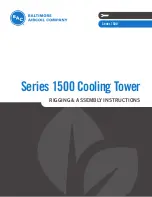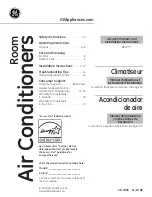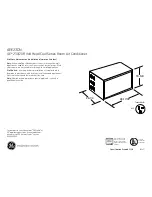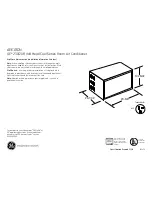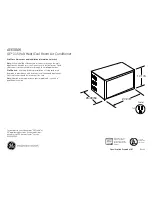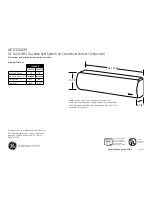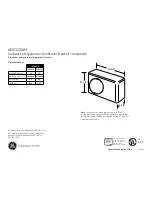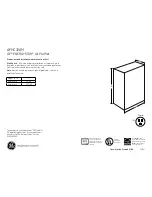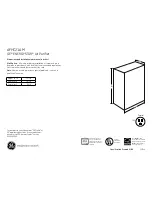
Page 6
# 504,910M
rated for use with R410A refrigerant. Wrap a wet cloth
around the valve body and the copper tube stub.
Remove light maroon washers from service valves
and shield light maroon stickers to protect them
during brazing. Braze the line set to the service valve.
4. Quench the joint with water or a wet cloth to prevent
heat damage to the valve core and opening port.
The
tube end must stay bottomed in the fitting during
final assembly to ensure proper seating, sealing,
and rigidity.
5. Flush line set and evaporator if required (refer to
Flushing Existing Line Set and Indoor Coil
on page
4).
6. Install the fixed orifice (supplied with unit) or R410A
approved thermal expansion valve (not supplied) in
the liquid line at the indoor coil. (See
Refrigerant
Metering Device
section that follows.)
7. Install the provided filter drier (approved for use with
R410A refrigerant) in the liquid line as close as
possible to the fixed orifice or expansion device.
Do
not leave the drier uncapped for more than 10 – 15
minutes prior to brazing, evacuation, and leak
testing. Polyol ester oils used in this system
absorb moisture quickly. Failure to install the filter
drier will void the warranty.
Refrigerant Metering Device
SCU12M units are designed for use with either a fixed
orifice or an expansion valve system. See the indoor coil
installation instructions approved TXV and fixed orifice
matchups and application information. Refer to the
appropriate following section for information on installing
the chosen refrigerant metering device.
6. Invert the cylinder of clean R22 and open its valve to
allow liquid refrigerant to flow into the system through
the suction line valve. Allow the refrigerant to pass
from the cylinder and through the line set and the
indoor coil before it enters the recovery machine.
7. After all of the liquid refrigerant has been recovered,
switch the recovery machine to vapor recovery so that
all of the R22 vapor is recovered. Allow the recovery
to pull a vacuum on the system.
NOTE:
A single system flush should remove all of the
mineral oil from the existing refrigerant lines and
indoor coil. A second flushing may be done (using
clean refrigerant) if insufficient amounts of mineral oil
were removed during the first flush.
Each time the
system is flushed, you must allow the recovery
machine to pull a vacuum on the system at the
end of the procedure.
8. Close the valve on the inverted R22 cylinder and the
gauge set valves. Pump the remaining refrigerant out
of the recovery machine and turn the machine off.
9. Use nitrogen to break the vacuum on the refrigerant
lines and indoor coil before removing the recovery
machine, gauges, and R22 refrigerant drum. Re-
install pressure tap valve cores into the SCU12M
service valves.
10. Install the provided orifice or expansion valve (ap-
proved for use with R410A refrigerant) in the liquid line
at the indoor coil.
Plumbing Connections Using New Indoor Coil and
Line Set
If refrigerant lines are to be routed through a wall, seal
and isolate the opening so vibration is not transmitted to
the building.
Line length should be no greater than 50'. Use Table 1 to
select line set diameters to ensure oil return to the com-
pressor.
Brazing Connection Procedure
1. The end of the refrigerant line must be cut square and
its internal shape must remain round. The line must
be free of nicks or dents and must be deburred (I.D.
and O.D.).
2. Before making line set connections, use dry nitrogen
to purge the refrigerant piping. This will help to
prevent oxidation and the introduction of moisture into
the system.
3. Use silver alloy brazing rods (5% or 6% silver alloy for
copper-to-copper brazing or 45% silver alloy for
copper-to-brass or copper-to-steel brazing) which are
Refrigerant Line Set Diameters
Table 1
l
e
d
o
M
d
i
u
q
i
L
e
n
i
L
n
o
i
t
c
u
S
e
n
i
L
4
2
0
-
M
2
1
U
C
S
0
3
0
-
M
2
1
U
C
S
6
3
0
-
M
2
1
U
C
S
.
n
i
8
/
3
)
m
m
0
1
(
.
n
i
4
/
3
)
m
m
9
1
(
2
4
0
-
M
2
1
U
C
S
8
4
0
-
M
2
1
U
C
S
.
n
i
8
/
3
)
m
m
0
1
(
.
n
i
8
/
7
)
m
m
2
2
(
0
6
0
-
M
2
1
U
C
S
.
n
i
8
/
3
)
m
m
0
1
(
.
n
i
8
/
1
-
1
)
m
m
9
2
(

















